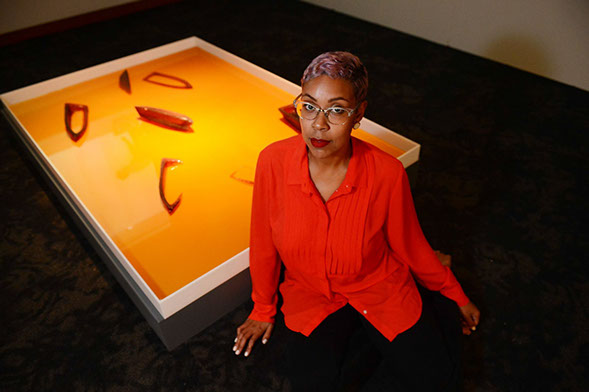
Andrea Chung with Bato Disik, 2013
photo: Tyrus Ortega Gaines Photography
Jason with Andrea Chung
J: What I see is that you take complicated subjects and you make work about those complicated subjects but you only use one or two materials and you only use one or two visual elements. So you’re stripping down to something, but what does that kind of economy mean to you?
AC: I think I tend to use one material just because I’m trying to take that material and look at all of the relationships that can be connected to that material and just keep pushing it further and further. How can I talk about migration in relation to –let’s say– sugar? How can I talk about colonialism in relation to sugar? How can I talk about labor in relation to sugar? How can I talk about the physical things that happen to you based on the ingesting of sugar? I think rather than jumping to another material, I tend to continue to explore and just push and see just how far I can take it.
J: When you talk about pushing, exploring, and seeing how far you can take it, you’re still just using one visual element. Does that mean that you’re talking about the ways that you plan for sculptures to change and break over time? Does that mean that you’re talking about the smell that you get? For instance, your sugar boats Bato Disik. They melt and they change the color of the water. Is that what you’re talking about?
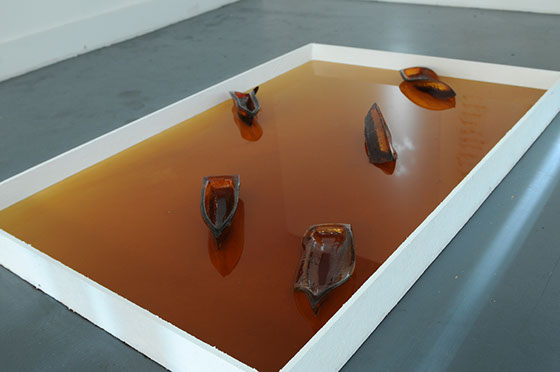
Bato Disik, 2013
photo: Courtesy Andrea Chung
AC: Yeah, those things aren’t always planned. I’ll have an idea and I think part of the exploration of a particular material like sugar… I think I was trying to control it a little too much. I wanted to use the material but I wanted to make it permanent so it just wouldn’t move. I was killing myself trying to achieve that instead of embracing the material the way painter would embrace a color or their own material –how they can do certain things with paint. So I started to slowly embrace some of the natural qualities of sugar. Of course it’s going to melt. I started thinking of how that can add to a concept or an idea. As far as the smell, with sugar I hadn’t really been thinking about that. But in previous pieces I did want to incorporate the scent of various spices into the piece so that the smell of something would trigger a memory. It was a happy accident with the sugar. I was cooking it so much that I couldn’t really smell it anymore. I was just used to that environment. So I liked that that sweetness and that smell is very seductive and it helps to get the viewer wanting to investigate the piece. In some way it’s bittersweet…in a corny way of using that word. I like that it draws you in. And as far as the color of the water, that was totally unplanned. I knew that the sugar would eventually melt into the water but I didn’t anticipate it melting so quickly. The first time I showed those boats, the piece, it was incredibly hot here in San Diego and they melted away in a matter of hours. I was sort of horrified when I came into the gallery space to see the work. But I think it added a quality to the piece that you can’t really plan for. You can’t control how it’s going to melt. I mean, you can to a degree, but the sugar melted in a very gradated sort of way. I got these really beautiful hues of amber and now that I know that that is a possibility, I can start to play with those unexpected qualities. I think that’s why I continue to work with the same material. Every time I do a piece, it always changes –which is scary and exciting at the same time. But I’ll learn something new from that experience, which allows me to take those things that I’ve learned and add it to the next piece or the next process –into an object.
J: So something else that I know about you and your work, just from watching you. You do a lot of research and planning and a lot of careful brainstorming. Then you just sort of throw it all away and see what happens.
AC: There’s definitely a lot of planning. It takes me a really long time to come up with a concept that I feel comfortable with. I think it’s also the nature of the subject. I want to be very responsible, but at the same time I want to create this narrative that’s not too complicated and not too overwhelming –that anyone who’s unfamiliar with the history of whatever location or people or culture that I’m speaking of can connect to it. And also if you’re not well versed in the arts, that you can still take something away from the work. I don’t think I intentionally throw it all away, but I do want to be concise in a visual way. Sometimes I think that so much stuff can be so busy and I don’t think that’s the aesthetic that works for me and for the stories that I’m trying to tell.
J: Concise is a good word. You have a visual identity that you’ve developed that always striven towards elegance in –not necessarily in form– but in expressing an idea or evoking a complicated process or history. And I know that it’s important to you that the viewer can see you or your hand in the work. Is there a tension or conflict there, that you want them to see hour hand but you want to strip away everything that’s not important?
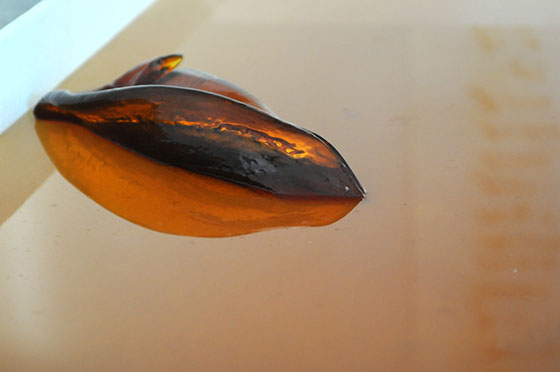
Bato Disik, 2013 detail
photo: Courtesy Andrea Chung
AC: There’s definitely tension. When I first started making work I hadn’t really thought about my personal process. I was trying to make something that was aesthetically pleasing. I think a lot of it has to do with the fact that I started out as a painter. And I wasn’t a trained sculpture. There’s an insecurity that comes with not knowing really how to make molds the way some of my peers can make molds. The history of sculpture wasn’t something that I was well versed in. I didn’t have the refinement in my sculptures or in my installations that I feel that I could sometimes get with painting. So that’s a thought process I went through. But I started to embrace my hand because I felt like it was an added part of the work. I really started to think about how the process related to the fact that I was talking about issues of labor. My labor becomes part of the story. Not in the sense of comparing my labor to their labor, but just showing the amount of work that goes into something –that I think people often times take for granted. It’s a struggle now because in some things that I do –for example I have these cut leaves called Natives– I try to get away from cutting two or three hundred different leaves, but I become engrossed in it. My labor becomes a big part of it because I’m talking about the artificial quality of these things and the work that goes into it. At the same time, I have to give up control in the sense that I can’t make every single thing. I have to get some things fabricated, like the large bath that my sugar boats sit in. I don’t have the technical skills to build that so I have to give that over. And oftentimes it does look a little more refined and polished. It’s a constant back and forth between how much of my own physical labor I want to invest in a piece vs. “you can get that pedestal made instead of having to take that work on yourself”.
J: You say you’re giving it over. Do you feel like you’re giving something up?
AC: Sometimes, yeah. Sometimes I question whether it makes the work more authentic, but I know that’s probably silly and a minor thing. But I really enjoy doing as much of it as possible. I don’t have assistants. I really try to learn how to do all these different processes on my own but I am deathly afraid of power tools. I try to stay away from those as much as possible. I just don’t want to lose a finger! And I have been stabbed several times by my own Exacto knives, so I know I’m not handy. But I try to learn the processes all on my own or I will refer to someone that I feel is really well versed in something. They just give me a couple tutorials on how to do something and I just wing it on my own. Sometimes it works and sometimes it’s not so great, but it’s a learning process. That’s just part of my practice.
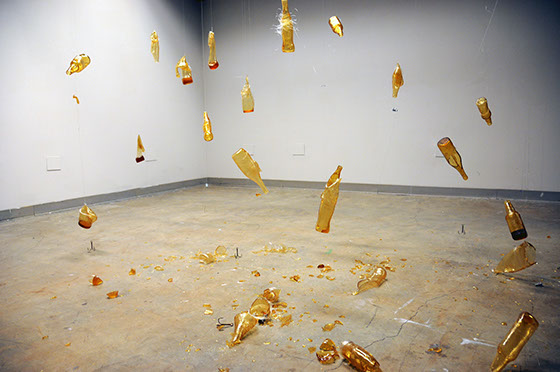
Sink & Swim, 2013
photo: Courtesy Andrea Chung
J: Another part of your practice is that you use history. You refer to it. It’s a foundation of what you do. The history of a subject and materials matter to you when you’re coming up with ideas and projects. And that's not to say that you’re compiling a history or writing a book report. But how do you deal with the urge to want to tell the history or process of a thing vs. the urge to make work that stands on its own without an explicit story line?
AC: I would say my work is pretty didactic. That’s a struggle. I’m trying to lean towards being less didactic now. I don’t want people to be so compelled with the story that they’re not critical of the aesthetics of the work. It’s something I try to balance. As far as my use of history, that’s you’re fault because you were a history major! I got really interested in a lot of the things you were learning! I would think about art in relationship to that and how to tell a story. I think I want to engage the viewer, but I don’t think I want to take such heavy material and bombard them and smack them in the face with it. I think people tend to tend to run away from that sort of thing. Especially when you’re talking about issues of race or colonialism or imperialism. Those subjects are very hard to swallow and digest for certain people. I try to find a basic way to tell a story. A lot of that for me is looking through materials. And a lot of people don’t really think about the mundane objects around them. How does sugar come packaged as nice and neatly as it does? Who is cutting down that cane and where specifically is it indigenous to? How does it get from one location to the next? I think all that gets lost in how easily accessible things are. I try to play with those ideas and find fresh ways to talk about that.
J: Is that a formula that you can apply to other stories or will you have to go through these soul seeing vision quests again once you move on to some other material?
AC: Well I’m working on a project now that is not related to sugar at all. I’m actually working with Cyanotypes, which is a totally new process to me. I was introduced to it by another artist who was originally a photographer and moved into sculpture. He showed me that I could take sugar bottles –because they’re translucent– I could put them on a processed piece of paper and expose it to the sun and get this water-like quality. I always wanted to play with that! But then I was like “it relates, but I don’t know what to do with that”. So now I’m working with that material and I think the same way that I look at the history of sugar, I’m looking at the history of the Cyanotype and it’s relationship to the Caribbean. The fact that there’s no real photography from the times that predate the abolishment of slavery… Looking at that and thinking of how there’s no actual evidence, no photographic evidence, –and people tend to believe photographic evidence more than anything else– I’m trying to take the history of that material and explore that in relation to this specific location. I definitely do think that the way I have explored the history of sugar or the history of various spices, and how that has impacted the Caribbean allow me to take the same research process and apply it to new ideas and new bodies of work.
J: Over the last decade or so, you’ve developed a visual identity. You have a vocabulary where you re-use some of the same metaphors. You re-use some of the same visual forms. Is your work one continuous series or is each project a self-contained set?
AC: I do think all the work relates, but sometimes I feel like I have a split practice –the work that I do in relation to the Caribbean vs. the work I do in relation to my experience in Mauritius. But the more I do this work, the more I’m starting to see how very much they’re interconnected. They’re both parts of the world that were affected by colonialism. Specifically, both locations were affected by the sugar trade. They relate in that way and I would like to think that the work I make is accessible to both parts of the world. When I make things, I do think that I’m making “this object”, but when I see it all together, I see how things relate a little bit more. I’m not really aware of it sometimes when I’m making. I’m just trying to make.
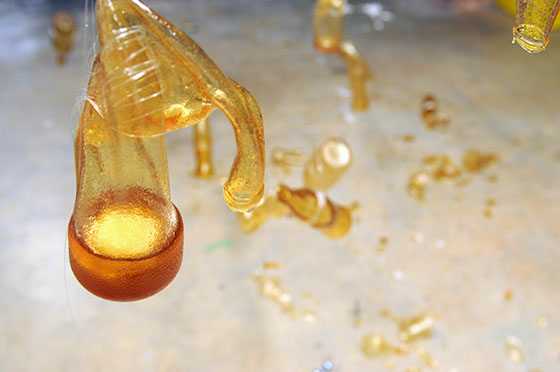
Sink & Swim, 2013 detail
photo: Courtesy Andrea Chung
J: A lot of your work, especially the work that deals with history, there is always a multi-generational process that you’re discussing. For instance, when the formerly enslaved people in Mauritius refused to work the cane fields for their former masters, they chose a job that would not facilitate them getting land ownership, which means their descendants wouldn’t own land, which means their current descendants have diminished political power. And you talk about all of that in a sugar bottle. Or you talk about the way colonial language maps directly to the language of tourism. Is that intentional? Do you always look at cross-generational stories?
AC: Yes. If you reach back, well the great example is anything anyone has ever made about slavery. People think about slavery as “Oh well that happened back then! That was like four hundred years ago.” No, it’s not four hundred years ago. It’s a lot more recent than that and I think you need to make the connection with how that impacts us currently. No matter where you are, everyone is impacted by this. It’s not just black folks. Everyone in the Caribbean is effected by slavery. It influences everything. It influences the way the culture is, the way we speak, the foods we eat. It impacts the economies that are there and what they’re able or unable to do. It effects their relationship to the US. There’s no way you can separate those things. So when I make the work, for example the work that I do on tourism, I tend to find and mine archival images of king workers. The transition of when slavery was abolished and this free labor was no longer available to these plantation owners, they had to find a viable way to survive. It automatically went from one service economy to another. They turned to tourism. So you’ll see images of the same king workers who are now laying in the fields chewing on the object of their labor (which is a pretty ridiculous notion). A lot of those images were used to promote tourism in paces like Jamaica to say “they’re free, but they’re still docile”. And if you look at present day travel magazines, you’ll see a lot of the same imagery. The people who are working at hotels aren’t laying in fields, but they’re still sort of standing in subservient positions of bending down. I feel like that hasn’t changed. It’s pretty much the same type of imagery from the past going into the present.
J: Speaking of slavery, I remember when I first met you, you said you didn’t want to make work about it because it was such a huge subject. You didn’t want to drown in it’s vastness. But with these pieces, you’ve found a way to chip away at that vastness and talk about small stories. They’re related to slavery, but only in the way that black people everywhere are related to slavery. They’re not specifically about slavery.
AC: I feel like it is such a huge topic. There have been tons of artists who have covered the subject matter. I feel like for me, there’s a different way to talk about it, but not really talk about it. I’m more interested in contemporary issues and how we’re effected and how there can be connections. So with pieces like Bain De Mer, with the sugar boats and the video projection, I want people who are the diaspora, no matter where you are, whether you be in Trinidad or Mauritius– that you can connect to the story, that you can find some understanding and some common ground. That was something that I did experience when we were in Mauritius for that year. When I went to Mauritius, I was really excited to know that there were Chinese Mauritians who were Hakka, which is exactly the same culture that my grandfather was from all the way in Jamaica. I started to see all these cultural connections and I started to see that a lot of the Mauritians there connected with Jamaican and Trinidadian culture. I feel like if I can make work that is versed in contemporary issues and things that are effecting different locations in a similar way, that’s where I want to go with the work.
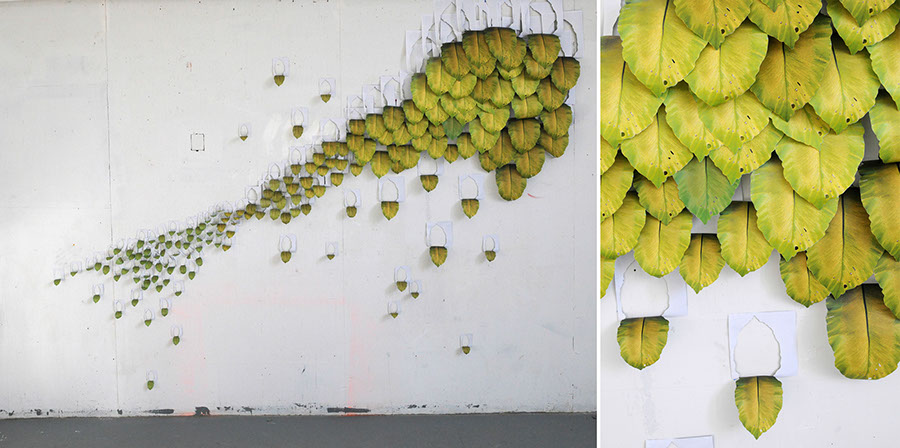
Natives I, 2014
photo: Courtesy Andrea Chung
Andrea Chung is an artist living and working in San Diego California. She received an MFA from Maryland Institute College of Art (MICA) in 2008. Her awards include a full fellowship to attend Skowhegan in 2008, a Fulbright Scholarship to Mauritius in 2009, a Joan Mitchell Fellowship to attend Vermont Studio Center in 2014, and a Joan Mitchell Foundation Painters and Sculptors Grant in 2014.
Disclaimer: All views and opinions expressed are those of the authors and do not necessarily reflect the views of the editors, owner, advertisers, other writers or anyone else associated with PAINTING IS DEAD.

